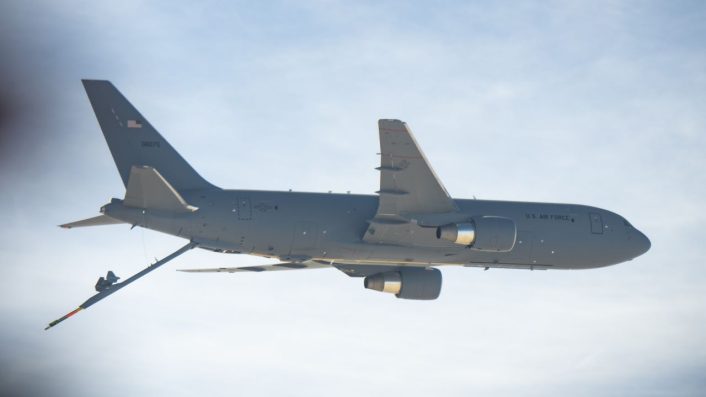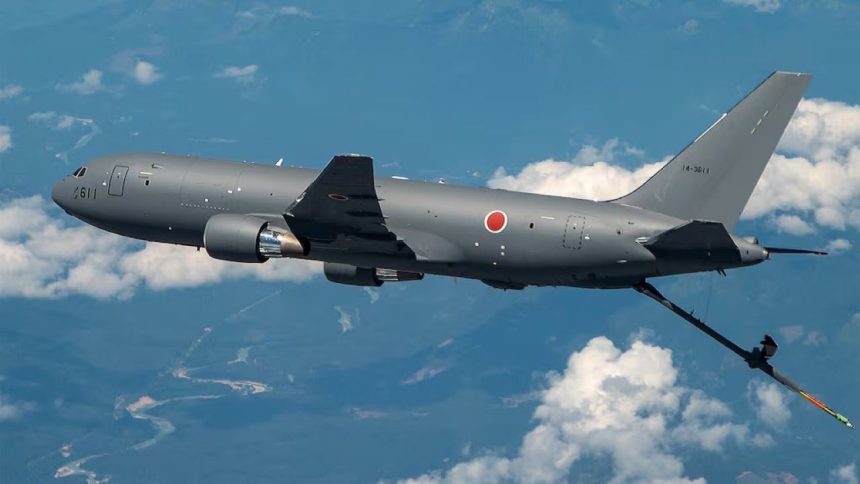The latest deal would take the number of KC-46As in Japan’s inventory to 15 aircraft, expanding the country’s reach and presence in the Western Pacific area.
The US State Department on Sep. 13, 2024 approved a possible sale of nine KC-46A Pegasus aerial refueling tankers, worth $4.1 billion, to Japan under a FMS (Foreign Military Sales) program, according to the U.S. DSCA (Defense Security Cooperation Agency)Cooperation Agency). This adds to six refuellers already on contract with Tokyo, four of which have been delivered to the JASDF (Japan Air Self-Defense Force) in Nov. 2021.
Therefore the latest proposal, if approved, would take the number of KC-46As in Japan’s inventory to 15 aircraft. Tokyo is the second international operator of Boeing’s KC-46A, the first being the U.S. Air Force. The KC-46As greatly enhance the JSDF’s (Japan Self-Defense Forces) reach and presence in the western Pacific before China, characterized by vast distances over the sea between the operational zones and Allied island bases.
The DSCA’s delivery of the required certification that notifies the Congress of the sale is however not final and requires approval from lawmakers. It is also subject to the final quantity/units and contract price, which are subject to negotiations, and the DSCA certification serves as a go-ahead from the political executive, before legislative approval.
2024.05.26
Japan Air Self Defense Force
BOEING KC-46A 44-3614
At Miho Airbase
今現在美保基地にいるKC-46の中で1番新しい機体である4号機。白いエプロン上でよく目立つ濃いグレーのボディにリバーサーのないPW4000と普段見ているB6とは程遠い姿ですがこれはこれで好きかも? pic.twitter.com/zQBDTjoW3M
— 舎路 (@Sharo_4681) May 31, 2024
Japan’s interest in more tankers was unexpected as previous statements did not foresee a possible increase of the fleet. The interest is however legitimated by the vast stretches of ocean which surround Japan and would render impossible any power projection attempt without enough tankers.
The U.S. Air Force also recently took delivery of two additional KC-46As since Jan. 2024 from Boeing. According to Breaking Defense, the company has delivered 10 of the 15 KC-46A Pegasus units it planned to complete in fiscal year 2024 (Oct. 1, 2023 to Sep. 30, 2024).
While the KC-46A Pegasus is gradually taking over more missions to lessen the load on KC-135’s units, it still has many issues. As of Jan. 2024, the KC-46 has six category 1 deficiencies, which could cause loss of an aircraft, injury, or death, according to the Air Force classification. Work is ongoing to fix them once for all.
The Japanese pursuit of additional KC-46As also comes shortly after the Italian decision to halt the acquisition of the aircraft that it announced on Jun. 24, 2024. These were meant to replace the KC-767s, and the program’s suspension was attributed to “changed and unforeseen needs.”
Other KC-46 related equipment
Beside the aircraft, the sale also includes 18 Pratt & Whitney PW4062 engines, which customers use for replacements or a source of spares during maintenance or mishaps.
Other support equipment for survivability include 16 AN/ALR-69A RWRs (Radar Warning Receiver); 33 LAIRCMs (Large Aircraft Infrared Countermeasure) GLTA (Guardian Laser Turret Assembly); 18 LAIRCM system processor replacements; MAWS (Missile Approach Warning Sensors); CAD/PADs (Cartridge or Propellant Actuated Devices); control interface units; UDM (User Data Module) cards; electronic warfare database support; KIV-77 crypto modules; KY-100 crypto terminals; AN/PYQ-10 SKL (Simple Key Loaders) and AN/APX-119 IFF (Identification Friend or Foe) transponders.
The other products include test, support and maintenance equipment, spare parts, components, accessories, training aids; classified and user technical documentation, studies and surveys and technical and logistical support.

Increasing tensions with China, North Korea and Russia
Interestingly, the number of aircraft is an increase from four KC-46As that the Japanese government was reported in late-August to have listed in its latest budget, for which it had set aside $1.4 billion. The $59 billion budget for fiscal Apr. 2025, up 7.4% from the previous one, also called for a multi-billion dollar network of small satellites, beside 400 U.S.-made Tomahawk missiles and an enhanced-range variant of its surface-launched Type 12 anti-ship missile.
The up-arming also comes amid Japan changing its defense-only oriented posture, announcing to undertake pre-emptive strikes on North Korean or Chinese targets if it believed it was going to be under attack.
Russia too had been breaching Japanese ADIZ (Air Defense Identification Zones). On Jul. 31, two Russian Tu-95MS strategic bombers and Su-30SM and Su-35S fighters as escorts conducted a 10-hour flight over the Sea of Japan, entering its ADIZ three times and prompting the JASDF (Japan Air Self-Defense Force) to scramble its fighters. This was followed by the first-of-its-kind proper violation of Japanese airspace by a Chinese Y-9 intelligence aircraft near Danjo islands, approximately 70 km southwest of the Nagasaki Prefecture.
Then on Sep. 12, the JASDF scrambled fighter jets after Russian aircraft flew around the archipelago for the first time in five years. The two Russian Tu-142 aircraft flew from the sea between Japan and South Korea toward the southern Okinawa region, the Japanese Ministry of Defense said in a statement.
【ロシア軍機の動向について】
12日(木)午前から午後にかけて、ロシア軍の哨戒機(Tu-142) ×2機が島根県隠岐島沖から対馬海峡を通過して東シナ海へ飛行した後、沖縄本島と宮古島との間を通過して太平洋を北上し、北海道沖から大陸方面に向け て飛行したことを確認し、これらに対し #航空自衛隊… pic.twitter.com/jVgFoq7g1F
— 防衛省統合幕僚監部 (@jointstaffpa) September 12, 2024
“The aircraft flew from the coast of Oki Island in Shimane Prefecture, through the Tsushima Strait, into the East China Sea, then passed between the main island of Okinawa and Miyako Island, headed north across the Pacific Ocean, and then flew off the coast of Hokkaido toward the continent. Fighter aircraft from the Central Air Defense Force and others were dispatched to respond to these aircraft,” the Joint Staff said on X.
The Japan Joint Staff also released a map of the aircraft’s route, which began and ended at southeastern Russia in the northern part of the western Pacific. It would be reasonable to expect that these heightened tensions with significant military overlap are driving the Japanese military acquisition plans. Moreover, having additional aerial refuelers also helps the United States, given its military and strategic alliance with Tokyo that has a high degree of equipment interoperability.









